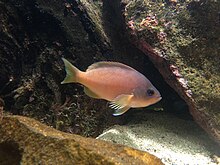The barber perch (Caesioperca rasor), also called the barber sea perch, red perch or Tasmanian barber, is endemic to Australia, found from southern Victoria to southwestern Western Australia, including Tasmania.[2]
| Barber perch | |
|---|---|

| |
| Scientific classification | |
| Domain: | Eukaryota |
| Kingdom: | Animalia |
| Phylum: | Chordata |
| Class: | Actinopterygii |
| Order: | Perciformes |
| Family: | Serranidae |
| Genus: | Caesioperca |
| Species: | C. rasor
|
| Binomial name | |
| Caesioperca rasor (Richardson, 1839) [1]
| |
| Synonyms[1] | |
| |
Description edit
The barber perch is a laterally compressed, deep-bodied fish growing to a maximum length of 26 cm (10 in). Females and larger juveniles are a pinkish colour with a large black vertical bar on the flank towards the posterior end and a blue streak just under the eye. Smaller juveniles additionally have a black head. Males are similarly marked but their overall hue is silvery or yellowish. They additionally have blue margins to the fins and a small blue spot on each scale.[2]
It differs from the closely related Butterfly perch by having a more slender body and males are more blue with a darker bar, rather than blotch, on the side.[3] The two species sometimes form mixed shoals.[3]
Behaviour edit
The barber perch is a schooling species of fish which forms dense shoals at depths down to about 180 m (591 ft).[4] It is largely a piscivore.[5]
References edit
- ^ a b Bailly, Nicolas (2014). "Caesioperca rasor (Richardson, 1839)". WoRMS. World Register of Marine Species. Retrieved 2014-02-24.
- ^ a b Barber Perch, Caesioperca rasor (Richardson, 1839), Australian Museum, 19 May 2009.
- ^ a b Bray, Dianne. "Barber Perch, Caesioperca rasor". Fishes of Australia. Retrieved 29 September 2014.
- ^ "Caesioperca rasor (Richardson, 1839): Barber perch". FishBase. Retrieved 2014-02-24.
- ^ Bulman, C.; Althaus, F.; He, X.; Bax, N. J.; Williams, A. (2001). "Diets and trophic guilds of demersal fishes of the south-eastern Australian shelf". Marine and Freshwater Research. 52 (4): 537–548. doi:10.1071/MF99152.